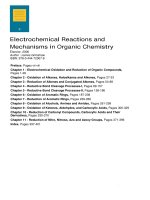Amino acids, peptides and proteins in organic chemistry 1 origins and synthesis of amino acids
Bạn đang xem bản rút gọn của tài liệu. Xem và tải ngay bản đầy đủ của tài liệu tại đây (5.69 MB, 708 trang )
Amino Acids, Peptides and Proteins
in Organic Chemistry
Edited by
Andrew B. Hughes
www.pdfgrip.com
Further Reading
Fessner, W.-D., Anthonsen, T.
Budisa, N.
Modern Biocatalysis
Engineering the Genetic Code
Stereoselective and Environmentally
Friendly Reactions
Expanding the Amino Acid Repertoire
for the Design of Novel Proteins
2009
2006
ISBN: 978-3-527-32071-4
ISBN: 978-3-527-31243-6
Sewald, N., Jakubke, H.-D.
Demchenko, A. V. (ed.)
Peptides: Chemistry and
Biology
Handbook of Chemical
Glycosylation
2009
Advances in Stereoselectivity and
Therapeutic Relevance
ISBN: 978-3-527-31867-4
Lutz, S., Bornscheuer, U. T. (eds.)
2008
ISBN: 978-3-527-31780-6
Protein Engineering
Handbook
Lindhorst, T. K.
2 Volume Set
2009
Essentials of Carbohydrate
Chemistry and Biochemistry
ISBN: 978-3-527-31850-6
2007
ISBN: 978-3-527-31528-4
Aehle, W. (ed.)
Enzymes in Industry
Production and Applications
2007
ISBN: 978-3-527-31689-2
Wiley-VCH (ed.)
Ullmanns Biotechnology and
Biochemical Engineering
2 Volume Set
2007
ISBN: 978-3-527-31603-8
www.pdfgrip.com
Amino Acids, Peptides and Proteins
in Organic Chemistry
Volume 1 - Origins and Synthesis of Amino Acids
Edited by
Andrew B. Hughes
www.pdfgrip.com
The Editor
Dr. Andrew B. Hughes
La Trobe University
Department of Chemistry
Victoria 3086
Australia
All books published by Wiley-VCH are carefully
produced. Nevertheless, authors, editors, and
publisher do not warrant the information contained
in these books, including this book, to be free of
errors. Readers are advised to keep in mind that
statements, data, illustrations, procedural details or
other items may inadvertently be inaccurate.
Library of Congress Card No.: applied for
British Library Cataloguing-in-Publication Data
A catalogue record for this book is available from the
British Library.
Bibliographic information published by
the Deutsche Nationalbibliothek
The Deutsche Nationalbibliothek lists this
publication in the Deutsche Nationalbibliografie;
detailed bibliographic data are available in the
Internet at .
# 2009 WILEY-VCH Verlag GmbH & Co. KGaA,
Weinheim
All rights reserved (including those of translation into
other languages). No part of this book may be
reproduced in any form – by photoprinting,
microfilm, or any other means – nor transmitted or
translated into a machine language without written
permission from the publishers. Registered names,
trademarks, etc. used in this book, even when not
specifically marked as such, are not to be considered
unprotected by law.
Composition Thomson Digital, Noida, India
Printing Strauss GmbH, Mörlenbach
Bookbinding Litges & Dopf GmbH, Heppenheim
Cover Design Schulz Grafik Design, Fgưnheim
Printed in the Federal Republic of Germany
Printed on acid-free paper
ISBN: 978-3-527-32096-7
www.pdfgrip.com
V
Contents
List of Contributors
XVII
Part One Origins of Amino Acids
1
1.1
1.2
1.2.1
1.2.2
1.3
1.4
1.4.1
1.4.1.1
1.4.1.2
1.4.1.3
1.4.1.4
1.4.2
1.5
1.6
1.7
1.8
2
2.1
1
Extraterrestrial Amino Acids 3
Z. Martins and M.A. Sephton
Introduction 3
ISM 6
Formation of Amino Acids in the ISM via Solid-Phase Reactions 6
Formation of Amino Acids in the ISM via Gas-Phase Reactions 8
Comets 9
Meteorites 11
Sources of Meteoritic Amino Acids (Extraterrestrial versus
Terrestrial Contamination) 17
Detection of Amino Acids that are Unusual in the Terrestrial
Environment 17
Determination of the Amino Acid Content of the Meteorite Fall
Environment 17
Determination of Enantiomeric Ratios 18
Determination of Compound-Specific Stable Isotope Ratios
of Hydrogen, Carbon, and Nitrogen 18
Synthesis of Meteoritic Amino Acids 19
Micrometeorites and IDPs 23
Mars 23
Delivery of Extraterrestrial Amino Acid to the Earth and its
Importance to the Origin of Life 24
Conclusions 26
References 27
‘‘Terrestrial’’ Amino Acids and their Evolution
Stephen Freeland
Introduction 43
43
Amino Acids, Peptides and Proteins in Organic Chemistry. Vol.1 – Origins and Synthesis of Amino Acids.
Edited by Andrew B. Hughes
Copyright Ó 2009 WILEY-VCH Verlag GmbH & Co. KGaA, Weinheim
ISBN: 978-3-527-32096-7
www.pdfgrip.com
VI
Contents
2.2
2.2.1
2.2.2
2.2.3
2.2.4
2.3
2.3.1
2.3.2
2.3.3
2.3.4
2.3.5
2.4
2.4.1
2.4.2
2.4.3
2.5
2.6
What are the 20 ‘‘Terrestrial’’ Amino Acids? 44
The 21st and 22nd Genetically Encoded Amino Acids 45
Do other Genetically Encoded Amino Acids Await Discovery? 46
Genetic Engineering can Enlarge the Amino Acid Alphabet 47
Significance of Understanding the Origins of the
Standard Alphabet 48
What do We Know about the Evolution of the Standard Amino
Acid Alphabet? 49
Nonbiological, Natural Synthesis of Amino Acids 50
Biosynthetic Theories for the Evolutionary Expansion of the
Standard Amino Acid Alphabet 53
Evidence for a Smaller Initial Amino Acid Alphabet 55
Proteins as Emergent Products of an RNA World 56
Stereochemical Rationale for Amino Acid Selection 57
Amino Acids that Life Passed Over: A Role for
Natural Selection? 58
Were the Standard Amino Acids Chosen for High
Biochemical Diversity? 60
Were the Standard Amino Acids Chosen for ‘‘Cheap’’
Biosynthesis? 62
Were the Standard Amino Acids Chosen to Speed Up Evolution? 62
Why Does Life Genetically Encode L-Amino Acids? 64
Summary, Synthesis, and Conclusions 64
References 66
Part Two Production/Synthesis of Amino Acids
3
3.1
3.2
3.3
3.4
3.4.1
3.5
3.6
3.6.1
3.6.2
3.6.3
3.7
3.7.1
77
Use of Enzymes in the Synthesis of Amino Acids 79
Theo Sonke, Bernard Kaptein, and Hans E. Schoemaker
Introduction 79
Chemo-Enzymatic Processes to Enantiomerically Pure
Amino Acids 80
Acylase Process 81
Amidase Process 83
Amidase Process for a,a-Disubstituted a-Amino Acids 86
Hydantoinase Process 88
Ammonia Lyase Processes 90
Aspartase-Catalyzed Production of L-Aspartic Acid 91
Production of L-Alanine from Fumaric Acid by
an Aspartase–Decarboxylase Cascade 92
Phenylalanine Ammonia Lyase-Catalyzed Production of
L-Phenylalanine and Derivatives 93
Aminotransferase Process 94
Aminotransferase-Catalyzed Production of D-a-H-a-Amino Acids
www.pdfgrip.com
97
Contents
3.8
3.9
AADH Process 99
Conclusions 102
References 103
4
b-Amino Acid Biosynthesis 119
Peter Spiteller
Introduction 119
Importance of b-Amino Acids and their Biosynthesis 119
Scope of this Chapter 119
Biosynthesis of b-Amino Acids 120
Biosynthesis of b-Alanine and b-Aminoisobutyric Acid 120
b-Alanine 120
b-Aminoisobutyric Acid 122
Biosynthesis of b-Amino Acids by 2,3-Aminomutases from
a-Amino Acids 122
b-Lysine, b-Arginine, and Related b-Amino Acids 124
b-Phenylalanine, b-Tyrosine, and Related b-Amino Acids 127
b-Glutamate and b-Glutamine 132
b-Leucine 132
b-Alanine 132
Biosynthesis of a,b-Diamino Acids from a-Amino Acids 132
General Biosynthesis of a,b-Diamino Acids 132
Structures and Occurrence of a,b-Diamino Acids in Nature 132
Biosynthesis of Selected a,b-Diamino Acids 135
Biosynthesis of b-ODAP 135
Biosynthesis of the a,b-Diaminopropanoic Acid Moiety in the
Bleomycins 136
Biosynthesis of the Penicillins 137
Biosynthesis of the Capreomycidine Moiety in Viomycine 137
Biosynthesis of the Streptolidine Moiety in Streptothricin F 137
Biosynthesis of a-Keto-b-Amino Acids from a-Amino Acids 139
De Novo Biosynthesis of b-Amino Acids by PKSs 139
Introduction 139
General Biosynthesis of Polyketide-Type b-Amino Acids 141
Structures and Occurrence of Polyketide-Type b-Amino Acids
in Nature 142
Biosynthesis of Selected Polyketide-Type b-Amino Acids 149
Long-Chain b-Amino Acids Occurring as Constituents of
the Iturins 149
Biosynthesis of the Ahda Moiety in Microginin 151
Biosynthesis of the Ahpa Residue in Bestatin 151
Biosynthesis of the Adda Residue in the Microcystins 152
b-Amino Acids Whose Biosynthesis is Still Unknown 152
Conclusions and Future Prospects 154
References 155
4.1
4.1.1
4.1.2
4.2
4.2.1
4.2.1.1
4.2.1.2
4.2.2
4.2.2.1
4.2.2.2
4.2.2.3
4.2.2.4
4.2.2.5
4.2.3
4.2.3.1
4.2.3.2
4.2.3.3
4.2.3.3.1
4.2.3.3.2
4.2.3.3.3
4.2.3.3.4
4.2.3.3.5
4.2.4
4.2.5
4.2.5.1
4.2.5.2
4.2.5.3
4.2.5.4
4.2.5.4.1
4.2.5.4.2
4.2.5.4.3
4.2.5.4.4
4.2.6
4.3
www.pdfgrip.com
VII
VIII
Contents
5
5.1
5.2
5.3
5.4
5.5
6
6.1
6.2
6.2.1
6.2.2
6.2.2.1
6.2.2.2
6.2.2.3
6.2.2.4
6.2.2.5
6.2.2.6
6.3
6.3.1
6.3.2
6.3.3
6.3.4
6.3.5
6.4
6.4.1
6.4.2
6.4.3
6.5
6.5.1
6.5.1.1
6.5.1.2
6.5.1.3
6.5.2
6.5.2.1
6.5.3
6.5.3.1
Methods for the Chemical Synthesis of Noncoded a-Amino
Acids found in Natural Product Peptides 163
Stephen A. Habay, Steve S. Park, Steven M. Kennedy,
and A. Richard Chamberlin
Introduction 163
Noncoded CAAs 164
Noncoded Amino Acids by Chemical Modification of Coded
Amino Acids 185
Noncoded Amino Acids with Elaborate Side-Chains 205
Conclusions 226
References 226
Synthesis of N-Alkyl Amino Acids 245
Luigi Aurelio and Andrew B. Hughes
Introduction 245
N-Methylation via Alkylation 246
SN2 Substitution of a-Bromo Acids 246
N-Methylation of Sulfonamides, Carbamates, and Amides 249
Base-Mediated Alkylation of N-Tosyl Sulfonamides 249
Base Mediated Alkylation of N-Nitrobenzenesulfonamides 250
N-Methylation via Silver Oxide/Methyl Iodide 252
N-Methylation via Sodium Hydride/Methyl Iodide 253
N-Methylation of Trifluoroacetamides 257
N-Methylation via the Mitsunobu Reaction 257
N-Methylation via Schiff s Base Reduction 259
Reduction of Schiff s Bases via Transition
Metal-Mediated Reactions 259
Reduction of Schiff s Bases via Formic Acid: The Leuckart
Reaction 260
Quaternization of Imino Species 261
Reduction of Schiff s Bases via Borohydrides 263
Borane Reduction of Amides 264
N-Methylation by Novel Methods 265
1,3-Oxazolidin-5-ones 265
Asymmetric Syntheses 272
Racemic Syntheses 277
N-Alkylation of Amino Acids 280
Borohydride Reduction of Schiff s Bases 280
Sodium Borohydride Reductions 281
Sodium Cyanoborohydride Reductions 281
Sodium Triacetoxyborohydride Reductions 282
N-Alkylation of Sulfonamides 282
Base-Mediated Alkylation of Benzene Sulfonamides 282
Reduction of N-Acyl Amino Acids 283
Reduction of Acetamides 284
www.pdfgrip.com
Contents
6.5.4
6.5.4.1
6.5.4.2
Novel Methods for N-Alkylating a-Amino Acids 284
Asymmetric Synthesis of N-Alkyl a-Amino Acids 284
N-Alkylation of 1,3-Oxazolidin-5-ones 284
References 286
7
Recent Developments in the Synthesis of b-Amino Acids 291
Yamir Bandala and Eusebio Juaristi
Introduction 291
Synthesis of b-Amino Acids by Homologation of a-Amino Acids 291
Chiral Pool: Enantioselective Synthesis of b-Amino Acids from
Aspartic Acid, Asparagine, and Derivatives 298
Synthesis of b-Amino Acids by Conjugate Addition of Nitrogen
Nucleophiles to Enones 300
Achiral b-Amino Acids 300
Enantioselective Approaches 304
Addition of ‘‘Chiral Ammonia’’ Equivalents to Conjugated
Prochiral Acceptors 304
Addition of a Nitrogen Nucleophile to a Chiral Acceptor 306
Asymmetric Catalysis 308
Synthesis of b-Amino Acids via 1,3-Dipolar Cycloaddition 312
Synthesis of b-Amino Acids by Nucleophilic Additions 316
Aldol- and Mannich-Type Reactions 316
Morita–Baylis–Hillman-Type Reactions 321
Mannich-Type Reactions 324
Synthesis of b-Amino Acids by Diverse Addition or
Substitution Reactions 328
Synthesis of b-Amino Acids by Stereoselective Hydrogenation
of Prochiral 3-Aminoacrylates and Derivatives 330
Reductions Involving Phosphorus-Metal Complexes 331
Reductions Involving Catalytic Hydrogenations 333
Synthesis of b-Amino Acids by use of Chiral Auxiliaries:
Stereoselective Alkylation 334
Synthesis of b-Amino Acids via Radical Reactions 338
Miscellaneous Methods for the Synthesis of b-Amino Acids 340
Conclusions 347
Experimental Procedures 348
Representative Experimental Procedure: Synthesis of (S)3-(tert-Butyloxycarbonylamino)-4-phenylbutanoic Acid 348
Representative Experimental Procedure: Synthesis of
(S)-2-(Aminomethyl)-4-phenylbutanoic Acid, (S)-19 350
Representative Experimental Procedure: Synthesis of b3-Amino Acids
by Conjugate Addition of Homochiral Lithium N-Benzyl-N(a-methylbenzyl)amide 352
Representative Experimental Procedure: Synthesis of Cyclic and
Acyclic b-Amino Acid Derivatives by 1,3-Dipolar Cycloaddition 353
7.1
7.2
7.3
7.4
7.4.1
7.4.2
7.4.2.1
7.4.2.2
7.4.2.3
7.5
7.6
7.6.1
7.6.2
7.6.3
7.7
7.8
7.8.1
7.8.2
7.9
7.10
7.11
7.12
7.13
7.13.1
7.13.2
7.13.3
7.13.4
www.pdfgrip.com
IX
X
Contents
7.13.5
7.13.6
7.13.7
7.13.8
8
8.1
8.2
8.2.1
8.2.2
8.2.3
8.2.4
8.2.5
8.2.6
8.2.7
8.2.8
8.3
8.4
8.4.1
8.4.2
8.4.3
8.4.4
8.4.5
8.4.6
8.5
8.6
8.6.1
Representative Experimental Procedure: Synthesis of (R)-3-tertButoxycarbonylamino-3-phenylpropionic Acid Isopropyl Ester using
a Mannich-Type Reaction 354
Representative Experimental Procedure: General Procedure for the
Hydrogenation of (Z)- and (E)-b-(Acylamino) acrylates by Chiral
Monodentate Phosphoramidite Ligands 354
Representative Experimental Procedure: Synthesis of Chiral
a-Substituted b-Alanine 355
Representative Experimental Procedure: Synthesis of Chiral b-Amino
Acids by Diastereoselective Radical Addition to Oxime Esters 357
References 358
Synthesis of Carbocyclic b-Amino Acids 367
Loránd Kiss, Enik}o Forró, and Ferenc Fülöp
Introduction 367
Synthesis of Carbocyclic b-Amino Acids 368
Synthesis of Carbocyclic b-Amino Acids via Lithium Amide-Promoted
Conjugate Addition 369
Synthesis of Carbocyclic b-Amino Acids by Ring-Closing
Metathesis 371
Syntheses from Cyclic b-Keto Esters 372
Cycloaddition Reactions: Application in the Synthesis of Carbocyclic
b-Amino Acids 375
Synthesis of Carbocyclic b-Amino Acids from Chiral Monoterpene
b-Lactams 377
Synthesis of Carbocyclic b-Amino Acids by Enantioselective
Desymmetrization of meso Anhydrides 378
Miscellaneous 379
Synthesis of Small-Ring Carbocyclic b-Amino Acid
Derivatives 383
Synthesis of Functionalized Carbocyclic b-Amino Acid
Derivatives 385
Enzymatic Routes to Carbocyclic b-Amino Acids 393
Enantioselective N-Acylations of b-Amino Esters 394
Enantioselective O-Acylations of N-Hydroxymethylated b-Lactams 394
Enantioselective Ring Cleavage of b-Lactams 395
Biotransformation of Carbocyclic Nitriles 396
Enantioselective Hydrolysis of b-Amino Esters 396
Analytical Methods for the Enantiomeric Separation of Carbocyclic
b-Amino Acids 397
Conclusions and Outlook 398
Experimental Procedures 399
Synthesis of Hydroxy Amino Ester Ethyl (1RÃ,2SÃ,4SÃ)2-(Benzyloxycarbonylamino)-4-hydroxycyclohexanecarboxylate (205a)
by Oxirane Ring Opening of with Sodium Borohydride 399
www.pdfgrip.com
Contents
8.6.2
8.6.3
8.6.4
8.6.5
8.6.6
8.6.7
8.6.8
9
9.1
9.2
9.2.1
9.2.1.1
9.2.1.2
9.2.1.3
9.2.2
9.2.2.1
9.2.2.2
9.2.3
9.3
9.3.1
9.3.2
9.3.3
9.3.4
9.3.5
9.3.6
9.4
Synthesis of Bicyclic b-Lactam (1RÃ,5SÃ)-6-azabicyclo[3.2.0]hept-3en-7-one (223) by the Addition of Chlorosulfonyl Isocyanate
to Cyclopentadiene 399
Synthesis of b-Amino Ester Ethyl cis-2-aminocyclopent3-enecarboxylate Hydrochloride (223a) by Lactam Ring-Opening
Reaction of Azetidinone 223 400
Synthesis of Epoxy Amino Ester Ethyl (1RÃ,2RÃ,3RÃ,5SÃ)-2(tert-butoxycarbonylamino)-6-oxabicyclo[3.1.0]hexane-3-carboxylate
(225) by Epoxidation of Amino Ester 224 400
Synthesis of Azido Ester Ethyl (1RÃ,2RÃ,3RÃ,4RÃ)-4-Azido-2(tert-butoxycarbonylamino)-3-hydroxycyclopentanecarboxylate (229)
by Oxirane Ring Opening of with Sodium Azide 401
Isomerization of Azido Amino Ester to Ethyl (1SÃ,2RÃ,3RÃ,4RÃ)4-Azido-2-(tert-butoxycarbonylamino)-3-hydroxycyclopentanecarboxylate
(230) 401
Lipase-Catalyzed Enantioselective Ring Cleavage of 4,5-Benzo-7azabicyclo[4.2.0]octan-8-one (271), Synthesis of (1R,2R)- and
(1S,2S)-1-Amino-1,2,3,4-tetrahydronaphthalene-2-carboxylic Acid
Hydrochlorides (307 and 308) 402
Lipase-Catalyzed Enantioselective Hydrolysis of Ethyl trans-2aminocyclohexane-1-carboxylate (298), Synthesis of (1R,2R)- and
(1S,2S)-2-Aminocyclohexane-1-carboxylic Acid Hydrochlorides
(309 and 310) 404
References 405
Synthetic Approaches to a,b-Diamino Acids 411
Alma Viso and Roberto Fernández de la Pradilla
Introduction 411
Construction of the Carbon Backbone 411
Methods for the Formation of the Cb–Cc Bond 411
Reaction of Glycinates and Related Nucleophiles with Electrophiles 411
Dimerization of Glycinates 416
Through Cyclic Intermediates 417
Methods in Which the Ca–Cb Bond is Formed 420
Nucleophilic Synthetic Equivalents of CO2R 420
Electrophilic Synthetic Equivalents of CO2R and Other Approaches 423
Methods in Which the CbCb0 or CcCc0 Bonds are Formed 424
Introduction of the Nitrogen Atoms in the Carbon Backbone 425
From Readily Available a-Amino Acids 425
From Allylic Alcohols and Amines 427
From Halo Alkanoates 428
From Alkenoates 429
Electrophilic Amination of Enolates and Related Processes 431
From b-Keto Esters and Related Compounds 433
Conclusions 433
www.pdfgrip.com
XI
XII
Contents
9.5
9.5.1
9.5.2
10
10.1
10.2
10.2.1
10.2.2
10.2.2.1
10.2.2.2
10.3
10.3.1
10.3.2
10.3.3
10.4
10.4.1
10.4.2
11
11.1
11.2
11.3
11.4
11.5
11.6
11.6.1
11.6.2
11.6.3
Experimental Procedures 434
(SS,2R,3S)-(ỵ)-Ethyl-2-N-(diphenylmethyleneamino)-3-N-(p-toluenesulnyl)-amino-3-phenylpropanoate (14b) 434
Synthesis of Ethyl (2R,3R)-3-amino-2-(4-methoxyphenyl)
aminopentanoate 32a via Asymmetric aza-Henry Reaction 434
References 435
Synthesis of Halogenated a-Amino Acids 441
Madeleine Strickland and Christine L. Willis
Introduction 441
Halogenated Amino Acids with a Hydrocarbon Side-Chain 442
Halogenated Alanines and Prolines 442
Halogenated a-Amino Acids with Branched Hydrocarbon
Side-Chains 445
Halogenated Valines and Isoleucines 445
Halogenated Leucines 451
Halogenated Amino Acids with an Aromatic Side-Chain 457
Halogenated Phenylalanines and Tyrosines 457
Halogenated Histidines 460
Halogenated Tryptophans 462
Halogenated Amino Acids with Heteroatoms in the Aliphatic
Side-Chain 463
Halogenated Aspartic and Glutamic Acids 463
Halogenated Threonine and Lysine 465
References 466
Synthesis of Isotopically Labeled a-Amino Acids 473
Caroline M. Reid and Andrew Sutherland
Introduction 473
Enzyme-Catalyzed Methods 473
Chiral Pool Approach 477
Chemical Asymmetric Methods 483
Conclusions 488
Experimental Procedures 489
Biocatalysis: Synthesis of [15N]L-amino Acids from a-Keto Esters
using a One-Pot Lipase-Catalyzed Hydrolysis and Amino Acid
Dehydrogenase-Catalyzed Reductive Amination 489
Chiral Pool: Preparation of Aspartic Acid Semi-Aldehydes as Key
Synthetic Intermediates; Synthesis of Methyl (2S)-N,N-di-tertbutoxycarbonyl-2-amino-4-oxobutanoate from L-aspartic Acid 489
Asymmetric Methods: Asymmetric Alkylation Using the Williams
Oxazine and Subsequent Hydrogenation to Give the
a-Amino Acid 490
References 491
www.pdfgrip.com
Contents
Synthesis of Unnatural/Nonproteinogenic a-Amino Acids 495
David J. Ager
12.1
Introduction 495
12.2
Chemical Methods 497
12.2.1
Resolution Approaches 497
12.2.2
Side-Chain Methods 497
12.2.2.1 Introduction of the Side-Chain 497
12.2.2.2 Modifications of the Side-Chain 500
12.2.3
Introduction of Functionality 502
12.2.3.1 Nitrogen Introduction 502
12.2.3.2 Carboxylic Acid Introduction 503
12.2.3.2.1 Strecker Reaction 503
12.2.4
Hydrogenation 504
12.2.5
Other Chemical Methods 508
12.3
Enzymatic Methods 508
12.3.1
Acylases 509
12.3.2
Hydantoinases 510
12.3.3
Ammonia Lyases 510
12.3.4
Transaminases 511
12.3.5
Dehydrogenases 513
12.3.6
Amino Acid Oxidases 514
12.3.7
Decarboxylases 515
12.4
Conclusions 516
12.5
Experimental Procedures 516
12.5.1
Side-Chain Introduction with a Phase-Transfer Catalyst 516
12.5.2
Introduction of Nitrogen Through an Oxazolidinone Enolate
with a Nitrogen Electrophile 517
12.5.3
Asymmetric Hydrogenation with Knowles Catalyst 518
12.5.4
Asymmetric Hydrogenation with Rh(DuPhos) Followed by EnzymeCatalyzed Inversion of the a-Center 519
References 520
12
13
13.1
13.2
13.2.1
13.2.2
13.2.3
13.2.4
13.2.5
13.3
13.3.1
13.3.1.1
Synthesis of g- and d-Amino Acids 527
Andrea Trabocchi, Gloria Menchi, and Antonio Guarna
Introduction 527
g-Amino Acids 528
GABA Analogs 528
a- and b-Hydroxy-g-Amino Acids 534
Alkene-Derived g-Amino Acids 539
SAAs 541
Miscellaneous Approaches 542
d-Amino Acids 547
SAAs 547
Furanoid d-SAA 547
www.pdfgrip.com
XIII
XIV
Contents
13.3.1.2
13.3.2
13.3.3
13.3.4
13.4
Pyranoid d-SAA 552
d-Amino Acids as Reverse Turn Mimetics 554
d-Amino Acids for PNA Design 562
Miscellaneous Examples 564
Conclusions 566
References 567
14
Synthesis of g-Aminobutyric Acid Analogs 573
Jane R. Hanrahan and Graham A.R. Johnston
Introduction 573
a-Substituted g-Amino Acids 575
b-Substituted g-Amino Acids 579
Pregabalin 581
Gabapentin 584
Baclofen and Analogs 584
g-Substituted g-Amino Acids 592
Vigabatrin 597
Halogenated g-Amino Acids 599
Disubstituted g-Amino Acids 600
a,b-Disubstituted g-Amino Acids 600
a,g-Disubstituted g-Amino Acids 601
b,b-Disubstituted g-Amino Acids 604
b,g-Disubstituted g-Amino Acids 604
Trisubstituted g-Amino Acids 604
Hydroxy-g-Amino Acids 605
a-Hydroxy-g-Amino Acids 605
b-Hydroxy-g-Amino Acids 606
a-Hydroxy-g-Substituted g-Amino Acids 619
b-Hydroxy-g-Substituted g-Amino Acids 619
b-Hydroxy-Disubstituted g-Amino Acids 638
Unsaturated g-Amino Acids 640
Unsaturated Substituted g-Amino Acids 641
Cyclic g-Amino Acids 644
Cyclopropyl g-Amino Acids 644
Cyclobutyl g-Amino Acids 648
Cyclopentyl g-Amino Acids 653
Cyclohexyl g-Amino Acids 663
Conclusions 666
Experimental Procedures 666
(R)-2-Ethyl-4-nitrobutan-1-ol (36c) 666
N-tert-Butyl-N-(p-chlorophenylethyl) a-Diazoacetamide 669
(R )-5-[(1-Oxo-2-(tert-butoxycarbonylamino)-3-phenyl)-propyl]-2,2dimethyl-1,3-dioxane-4,6-dione 670
(R )- and (S)-[2-(Benzyloxy) ethyl]oxirane 671
14.1
14.2
14.3
14.3.1
14.3.2
14.3.3
14.4
14.4.1
14.5
14.6
14.6.1
14.6.2
14.6.3
14.6.4
14.7
14.8
14.8.1
14.8.2
14.8.3
14.8.4
14.8.5
14.9
14.9.1
14.10
14.10.1
14.10.2
14.10.3
14.10.4
14.11
14.12
14.12.1
14.12.2
14.12.3
14.12.4
www.pdfgrip.com
Contents
14.12.5
14.12.6
14.12.7
14.12.8
14.12.9
Dimethyl (S,S)-(–)-3-N,N-bis(a-Methylbenzyl)-amino-2oxopropylphosphonate 672
Boc-L-leucinal 673
Cross-Coupling of N-tert-Butylsulfinyl Imine and tert-Butyl
3-oxopropanoate 674
(10 S,4S)-4-Bromomethyl-1-(1-phenyleth-1-yl)-pyrrolidin-2-one
(ỵ)-(R,S)-4-Amino-2-cyclopentene-1-carboxylic Acid 676
References 677
Index
691
www.pdfgrip.com
675
XV
XVII
List of Contributors
David J. Ager
DSM Pharma Chemicals
PMB 150
9650 Strickland Road, Suite 103
Raleigh, NC 27615
USA
Roberto Fernández de la Pradilla
CSIC
Instituto de Química Orgánica
Juan de la Cierva 3
28006 Madrid
Spain
Luigi Aurelio
Monash University
Department of Medicinal Chemistry
Victorian College of Pharmacy
381 Royal Parade
Parkville, Victoria 3052
Australia
Enik}
o Forró
University of Szeged
Institute of Pharmaceutical Chemistry
tvưs u. 6
6720 Szeged
Hungary
Yamir Bandala
Centro de Investigación y de Estudios
Avanzados del Instituto Politécnico
Nacional
Departamento de Química
Apartado Postal 14-740
07000 México DF
México
A. Richard Chamberlin
University of California, Irvine
Departments of Chemistry
Pharmaceutical Sciences, and
Pharmacology
Irvine, CA 92697
USA
Stephen Freeland
University of Maryland
Baltimore County
Department of Biological Sciences
1000 Hilltop Circle,
Baltimore, MD 21250
USA
Ferenc Fülöp
University of Szeged
Institute of Pharmaceutical Chemistry
Eötvös u. 6
6720 Szeged
Hungary
Amino Acids, Peptides and Proteins in Organic Chemistry. Vol.1 – Origins and Synthesis of Amino Acids.
Edited by Andrew B. Hughes
Copyright Ó 2009 WILEY-VCH Verlag GmbH & Co. KGaA, Weinheim
ISBN: 978-3-527-32096-7
www.pdfgrip.com
XVIII
List of Contributors
Antonio Guarna
Università degli Studi di Firenze
Polo Scientifico e Tecnologico
Dipartimento di Chimica Organica
‘‘Ugo Schiff ’’
Via della Lastruccia 13
50019 Sesto Fiorentino
Firenze
Italy
Eusebio Juaristi
Centro de Investigación y de Estudios
Avanzados del Instituto Politécnico
Nacional
Departamento de Química
Apartado Postal 14-740
07000 México DF
México
Stephen A. Habay
University of California, Irvine
Department of Chemistry
Irvine, CA 92697
USA
Bernard Kaptein
DSM Pharmaceutical Products
Innovative Synthesis & Catalysis
PO Box 18
6160 MD Geleen
The Netherlands
Jane R. Hanrahan
University of Sydney
Faculty of Pharmacy
Sydney, NSW 2006
Australia
Steven M. Kennedy
University of California, Irvine
Department of Chemistry
Irvine, CA 92697
USA
Graham A.R. Johnston
University of Sydney
Adrien Albert Laboratory of Medicinal
Chemistry
Department of Pharmacology
Faculty of Medicine
Sydney, NSW 2006
Australia
Loránd Kiss
University of Szeged
Institute of Pharmaceutical Chemistry
Eötvös u. 6
6720 Szeged
Hungary
Andrew B. Hughes
La Trobe University
Department of Chemistry
Victoria 3086
Australia
Z. Martins
Imperial College London
Department of Earth Science and
Engineering
Exhibition Road
London SW7 2AZ
UK
www.pdfgrip.com
List of Contributors
Gloria Menchi
Università degli Studi di Firenze
Polo Scientifico e Tecnologico
Dipartimento di Chimica Organica
‘‘Ugo Schiff ’’
Via della Lastruccia 13
50019 Sesto Fiorentino
Firenze
Italy
Steve S. Park
University of California, Irvine
Department of Chemistry
Irvine, CA 92697
USA
Caroline M. Reid
University of Glasgow, WestChem
Department of Chemistry
The Joseph Black Building
University Avenue
Glasgow G12 8QQ
UK
M.A. Sephton
Imperial College London
Department of Earth Science and
Engineering
Exhibition Road
London SW7 2AZ
UK
Hans E. Schoemaker
DSM Pharmaceutical Products
Innovative Synthesis & Catalysis
PO Box 18
6160 MD Geleen
The Netherlands
Theo Sonke
DSM Pharmaceutical Products
Innovative Synthesis & Catalysis
PO Box 18
6160 MD Geleen
The Netherlands
Peter Spiteller
Technische Universität München
Institut für Organische Chemie und
Biochemie II
Lichtenbergstraße 4
85747 Garching bei München
Germany
Madeleine Strickland
University of Bristol
School of Chemistry
Cantock's Close
Bristol BS8 1TS
UK
Andrew Sutherland
University of Glasgow, WestChem
Department of Chemistry
The Joseph Black Building
University Avenue
Glasgow G12 8QQ
UK
Andrea Trabocchi
Università degli Studi di Firenze
Polo Scientifico e Tecnologico
Dipartimento di Chimica Organica
‘‘Ugo Schiff ’’
Via della Lastruccia 13
50019 Sesto Fiorentino
Firenze
Italy
Alma Viso
CSIC
Instituto de Química Orgánica
Juan de la Cierva 3
28006 Madrid
Spain
Christine L. Willis
University of Bristol
School of Chemistry
Cantocks Close
Bristol BS8 1TS
UK
www.pdfgrip.com
XIX
Part One
Origins of Amino Acids
Amino Acids, Peptides and Proteins in Organic Chemistry. Vol.1 – Origins and Synthesis of Amino Acids.
Edited by Andrew B. Hughes
Copyright Ó 2009 WILEY-VCH Verlag GmbH & Co. KGaA, Weinheim
ISBN: 978-3-527-32096-7
www.pdfgrip.com
j3
1
Extraterrestrial Amino Acids
Z. Martins and M.A. Sephton
1.1
Introduction
The space between the stars, the interstellar medium (ISM), is composed of gasphase species (mainly hydrogen and helium atoms) and submicron dust grains
(silicates, carbon-rich particles, and ices). The ISM has many different environments
based on its different temperatures (Tk), hydrogen density (nH), and ionization state
of hydrogen (for reviews, see [1–3]); it includes the diffuse ISM (Tk $ 100 K,
nH $ 10–300 cmÀ3), molecular clouds (Tk $ 10–100 K, nH $ 103–104 cmÀ3; e.g., [4])
[molecular clouds are not uniform but instead have substructures [5] – they contain
high-density clumps (also called dense cores; nH $ 103–105 cmÀ3), which have
higher densities than the surrounding molecular cloud; even higher densities are
found in small regions, commonly known as hot molecular cores, which will
be the future birth place of stars], and hot molecular clouds (Tk $ 100–300 K,
nH $ 106–108 cmÀ3; e.g., [6]). Observations at radio, millimeter, submillimeter, and
infrared frequencies have led to the discovery of numerous molecules (currently
more than 151) in the interstellar space, some of which are organic in nature
(Table 1.1; an up-to-date list can be found at www.astrochemistry.net). The collapse
of a dense cloud of interstellar gas and dust leads to the formation of a so-called solar
nebula. Atoms and molecules formed in the ISM, together with dust grains are
incorporated in this solar nebula, serving as building blocks from which future
planets, comets, asteroids, and other celestial bodies may originate. Solar system
bodies, such as comets (e.g., [7] and references therein; [8]), meteorites (e.g., [9, 10]),
and interplanetary dust particles (IDPs [11, 12]) are known to contain extraterrestrial
molecules, which might have a heritage from interstellar, nebular, and/or parent
body processing. Delivery of these molecules to the early Earth and Mars during the
late heavy bombardment (4.5–3.8 billion years ago) may have been important for the
origin of life [13, 14]. Among the molecules delivered to the early Earth, amino acids
may have had a crucial role as they are the building blocks of proteins and enzymes,
therefore having implications for the origin of life. In this chapter we describe
different extraterrestrial environments where amino acids may be present and
Amino Acids, Peptides and Proteins in Organic Chemistry. Vol.1 – Origins and Synthesis of Amino Acids.
Edited by Andrew B. Hughes
Copyright Ó 2009 WILEY-VCH Verlag GmbH & Co. KGaA, Weinheim
ISBN: 978-3-527-32096-7
www.pdfgrip.com
3
H3ỵ
CH2
NH2
H2O
H2Oỵ
C 2H
HCN
HNC
HCO
HCOỵ
HN2ỵ
HOCỵ
HNO
H2S
H2Sỵ
C3
C 2O
CO2
CO2ỵ
N2O
HCSỵ
NaCN
MgCN
2
H2
CH
CHỵ
NH
OH
OHỵ
HF
C2
CN
CNỵ
CO
COỵ
N2ỵ
SiH
NO
CFỵ
HS
HSỵ
HCl
SiC
SiN
CP
CS
CH3
NH3
H3Oỵ
C2H2
H2CN
HCNHỵ
H2CO
c-C3H
l-C3H
HCCN
HNCO
HNCO
HOCOỵ
H2CS
C3N
C3O
HNCS
SiC3
C3S
4
CH4
NH4ỵ
CH2NH
H3COỵ
SiH4
c-C3H2
H2CCC
CH2CN
H2CCO
NH2CN
HCOOH
C4H
C4H
HC3N
HCCNC
HNCCC
C5
5
C2H4
CH3OH
CH3CN
CH3NC
NH2CHO
CH3SH
H2CCCC
HCCCCH
H2C3Nỵ
c-H2C3O
HC2CHO
C5H
HC4N
C5N
SiC4
6
CH3NH2
CH3CCH
c-C2H4O
CH3CHO
CH2CHCN
C6H
C6H
HC5N
7
CH3CH3
C3H4O
CH2OHCHO
CH3COOH
HCOOCH3
CH2CCHCN
CH3C3N
C6H2
HCCCCCCH
C7H
8
Number of atoms
Table 1.1 Summary of molecules identified in the interstellar and circumstellar mediuma.
C2H5OH
CH3OCH3
CH3CH2CN
CH3CONH2
CH3C4H
C8H
C8HÀ
HC7N
9
CH3CH2CHO
CH3COCH3
HOCH2CH2OH
NH2CH2COOH
10
CH3C6H
HC9N
11
C6H6
12
HC11N
13
4
j 1 Extraterrestrial Amino Acids
www.pdfgrip.com
MgNC
c-SiC2
AlNC
SiCN
SiNC
C 2S
OCS
SO2
Observations suggest the presence of polycyclic aromatic hydrocarbons in the interstellar gas (e.g., [244]).
a
SiO
PN
AlF
NS
SO
SOỵ
NaCl
SiS
AlCl
S2
FeO
KCl
1.1 Introduction
www.pdfgrip.com
j5
j 1 Extraterrestrial Amino Acids
6
H
H
O
H
H
O
O
N
H
N
H
H
H
H
O
H
I
II
Figure 1.1 Molecular structures of conformers I and II of glycine
in the gas phase (adapted from [21, 29]).
detected, their proposed formation mechanisms, and possible contribution to the
origin of life on Earth.
1.2
ISM
The search for amino acids, in particular for the simplest amino acid glycine
(NH2CH2COOH), in the ISM has been carried on for almost 30 years [15–28].
While in theory glycine may have several conformers in the gas phase [29], astronomical searches have only focused on two (Figure 1.1, adapted from [21, 29]).
Conformer I is the lowest energy form, while conformer II has a higher energy, larger
dipole moment, and therefore stronger spectral lines [30]. Only upper limits of both
conformers were found in the ISM until Kuan et al. [25] reported the detection
of glycine in the hot molecular cores Sgr B2(N-LMH), Orion-KL, and W51 e1/e2.
This detection has been disputed by Snyder et al. [26], who concluded that the spectral
lines necessary for the identification of interstellar glycine have not yet been found.
In addition, they argued that some of the spectral lines identified as glycine by
Kuan et al. [25] could be assigned to other molecular species. Further negative results
include the astronomical searches of Cunningham et al. and Jones et al. [27, 28], who
claim that their observations rule out the detection of both conformers I and II of
glycine in the hot molecular core Sgr B2(N-LMH). They conclude that it is unlikely
that Kuan et al. [25] detected glycine in either Sgr B2(N-LMH) or Orion-KL. No other
amino acid has been detected in the ISM. Despite these results, amino acids were
proposed to be formed in the ISM by energetic processing on dust grain surfaces,
which will then be evaporated, releasing the amino acids into the gas phase (solidphase reactions), or synthesized in the gas phase via ion–molecule reactions (gasphase reactions). These two processes will now be described in more detail (for a
review, see, e.g., [31]).
1.2.1
Formation of Amino Acids in the ISM via Solid-Phase Reactions
Several mechanisms have been proposed for amino acid formation in the ISM.
These include solid-phase reactions on interstellar ice grains by energetic processing,
www.pdfgrip.com
1.2 ISM
Table 1.2 Abundances of interstellar ices (normalized to H2O) in the
high-mass protostellar objects W33A and NGC758:IRS9, in the lowmass protostellar object Elias 29, and the field star Elias 16.
Ice specie
W33A
high-mass
protostar
NGC758:IRS9
high-mass
protostar
Elias 29
low-mass
protostar
Elias 16
field star
H2O
CO
CO2
CH4
CH3OH
H2CO
NH3
OCS
C2H6
HCOOH
O2
OCN–
100
9
14
2
22
1.7–7
3–15
0.3
<0.4
0.4–2
<20
3
100
16
20
2
5
5
13
0.05
<0.4
3
—
1
100
5.6
22
<1.6
<4
—
<9.2
<0.08
—
—
—
<0.24
100
25
15
—
<3.4
—
<6
—
—
—
—
<0.4
Adapted from [31, 32, 52].
which may occur in cold molecular clouds (e.g., [32] and references therein). In these
regions of the ISM, in which temperatures are very low (<50 K), atoms and molecules
in the gas phase will be accreted onto the surface of dust grains leading to the
formation of ice mantles [33, 34]. Diffusion of accreted atoms leads to surface
reactions, forming additional species in the ice mantles. These interstellar ices are
mainly composed of H2O, CO, CO2, CH4, CH3OH, and NH3, with traces of other
species (Table 1.2; [32, 34–38]). Once these ice grains are formed, energetic processes
[e.g., cosmic rays and ultraviolet (UV) irradiation] may change the ice mantle
composition.
A range of interstellar ice analogs have been irradiated at low temperatures ($10 K)
to produce a variety of amino acids. Holtom et al. [39] used galactic cosmic ray
particles to irradiate an ice mixture containing carbon dioxide (CO2) and methylamine (CH3NH2), which produced hydroxycarbonyl (HOCO) and aminomethyl
(CH2NH2) radicals. The recombination of these radicals would then form glycine
and its isomer (CH3NHCOOH). Briggs et al. [40] UV-irradiated a mixture of CO :
H2O : NH3 (5 : 5 : 1) at 12 K for 24 h. This resulted in the formation of an organic
residue, which included among other organic compounds, 0.27% of glycine. Ice
mixtures containing H2O : CH3OH : NH3 : CO : CO2 (2 : 1 : 1 : 1 : 1 molar composition; [41]), and H2O with NH3, CH3OH, and HCN (0.5–5% NH3, 5–10% CH3OH,
and 0.5–5% HCN, relative to H2O [42]) were UV-irradiated in high vacuum at below
15 K. While Bernstein et al. [42] obtained glycine and racemic mixtures (D/L $ 1) of
alanine and serine, a large variety of amino acids were found by Munõz Caro et al. [41].
These results were confirmed by Nuevo et al. [43, 44].
The exact formation pathway of amino acids in interstellar ices is unknown, but the
Strecker synthesis ([42]; for more details, see Section 1.4), reactions on the surface of
www.pdfgrip.com
j7









